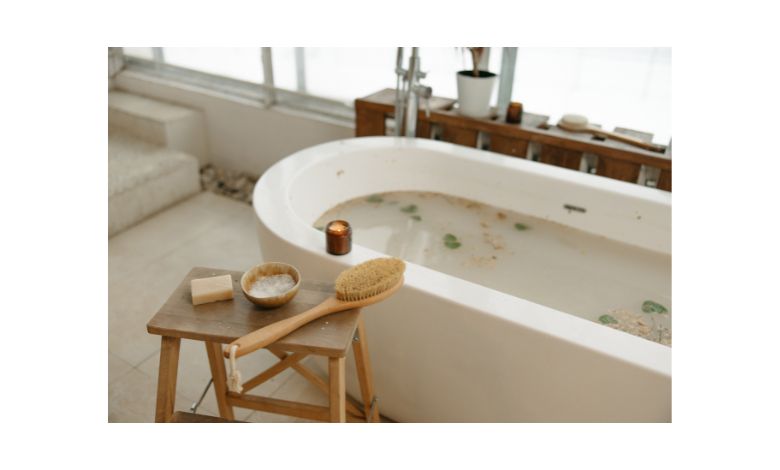Discover forest bathing benefits for stress relief, better sleep, and emotional healing with this peaceful beginner’s guide to nature therapy.
It was a cold Saturday morning, and I had reached a wall. The kind of wall that makes you tired all around, not just in your bones. I couldn’t focus on my work since my phone kept buzzing, and sleep seemed like a nap I had last year.
I did something that wasn’t like me.
I took a thermos of tea to a nearby nature preserve and left my phone at home. I wasn’t there to go trekking. I didn’t count how many steps I took. I just walked. Not right away. I could hear the wind blowing through the leaves, see a squirrel running from tree to tree, and feel the soft crunch of the ground under my boots.
And then something happened. I felt something change.
That was the beginning of my journey into the healing enchantment of forest bathing, and I haven’t looked back since.
What You'll Discover:
What does it mean to take a bath in the woods?
To be clear, “forest bathing” doesn’t mean bathing in the woods. But I’m not criticizing you if that’s what you like. The Japanese word Shinrin-yoku means “bathing in the forest atmosphere” or “taking in the forest through our senses.”
Shinrin-yoku is a sort of eco-therapy that was first used in the 1980s. Japan’s answer to a mental health problem that was getting worse because people were working too much, living in cities, and not spending enough time outside. And you know what? It works. And now it’s getting popular all around the world.
Hiking is usually about getting to a certain place or distance, while forest bathing is more about taking your time and being aware of what’s going on around you in nature. You don’t want to “do” anything. You’re just trying to get by.
The Science and Soul of Why Being in the Woods Is Good for You
When I talk about bathing in the woods, a lot of my friends look at me funny.
“Are you saying that being in the woods can make me feel better?”
Yes, I agree with it. Yes, it can.
This is why:
1. It decreases the hormones that make you feel stressed.
Research indicates that being in a forest decreases cortisol levels, the hormone responsible for stress. A 2010 study published in Environmental Health and Preventive Medicine revealed that participants who walked in a forest exhibited significantly reduced cortisol levels, a decreased heart rate, and lower blood pressure.
I didn’t need research to tell me that. I felt like a tremendous weight had been lifted off my shoulders as soon as I stood under the pine trees. I didn’t even know I was stressed, but it went away all of a sudden.
This is one of the most immediate forest bathing benefits you’ll notice.
2. It makes you feel better and is healthy for your mind.
Many people think that swimming in the woods might help with anxiety and despair. The sights, sounds, and smells of a forest all help you relax. Some examples are the sound of birds singing, the fragrance of pine, and the sound of leaves rustling.
Do you ever notice how you feel different when you’re among gray concrete instead of green concrete? That’s how your brain heals itself when it reacts to things that happen in the environment.
When I’ve been under trees, I’ve sobbed. Not because I was sad, but because I was okay with how I felt. That’s tough.
And it’s one of the deeper, more emotional forest bathing benefits I personally cherish.
3. It helps the body fight off sickness.
Throughout the forest, trees let forth phytoncides into the air. These are substances that kill germs. When we breathe them in, they make our bodies’ natural killer (NK) cells work harder, which helps our immune system. One study indicated that this effect can last for up to a week after only one trip to the woods.
If the forest gives you free medicine, you don’t need to take vitamins.
This is one of those long-lasting forest bathing benefits that science continues to support.
4. It makes it easier for you to sleep.
I found that I was sleeping better and woke up feeling better after swimming in the woods a few times. Being outside boosts your body’s internal schedule and soothes your nervous system, which makes it simpler for you to sleep.
Better sleep is often one of the most celebrated forest bathing benefits, especially in our screen-saturated world.
My Journey: From Stress to Balance
I used to really dig the hustle culture, but then I started going to the woods.
I thought I was doing well if I could tick items off my to-do list, get texts on my phone, and accomplish a number of different things at once. It felt sluggish to take a break. Being quiet made me feel like I was giving up.
But the woods have their own rhythm.
The pace of nature is sluggish. The growth rings of trees don’t matter to each other. The way rivers flow stays the same. Nothing else exists. Being around that kind of person helped me pay greater attention to what’s going on in my life.
Every week, I went to the woods. It can take anywhere from 20 minutes to two hours. Alone or with someone you trust. It doesn’t matter what the weather is like.
And bit by bit, I started to feel like myself again.
How to Go Forest Bathing: Easy Steps for Newbies
You don’t need any special equipment, fitness level, or knowledge to try bathing in the woods. Be open-minded, curious, and ready to turn off your phone.
1. Find your woodland
Choose a park, a walk through the woods, a forest, or a quiet garden with trees.
It doesn’t have to be wild or far away; it just needs trees, plants, and sounds from outside.
2. Don’t take your phone with you or turn it off.
This can’t be changed. You’re not keeping track of stuff. You aren’t texting. You are.
3. Go in gently and with a plan.
Stop near the edge of the trees. Take a deep breath. Say something nice to yourself, like “I’m here to pay attention” or “I’m here to slow down.”
4. Use all five senses.
- See how the light reflects through the leaves.
- Hear the birds? What about the wind? Sounds of rustling coming from far away?
- Smell: Take a deep breath and sniff. What does the forest smell like at this time?
- Touch: Put your fingers on the tree’s bark. Feel the dirt or moss.
- Taste: Did you get some herbal tea or mint from the wild? Be careful while you drink.
5. Don’t rush or make plans.
You don’t want to go anywhere. This workout doesn’t make your heart rate go up.
If you want to, walk slowly, stop a lot, and sit down.
Instead of utilizing a map, let your body do the work.
6. Give it some thought.
After your session, you can write in a notepad, sketch, or just sit quietly.
Think about what you saw. How do I feel right now?
Don’t Have a Forest? What to Do
You might be thinking, “That’s great for people who live near a forest, but what about me?”
The good news is that you don’t need a huge national park. You could also try these:
- Urban Parks: A lot of cities offer hidden gems, including peaceful, green parks with trees and fewer people.
- Community Gardens: If there’s soil, there’s calm.
- Your Own Backyard or Balcony: Sit under a tree, among plants, or even with potted greenery.
- Virtual Forest Bathing: Guided audio experiences can help you relax by letting you hear and visualize forest sounds.
How Often Should You Take a Bath in the Woods?
Once a week for 20 to 30 minutes will make you feel better and less worried. That’s excellent if you can go more often. If not, don’t worry. Nature is always with you.
The amount doesn’t matter. It depends on how often you’re there.
Bathing in the Woods vs. Hiking or Walking
You can tell yourself, “I’m fine because I go outside.”
Not really.
| Activity | Focus | Speed | Goal |
| Hiking | Fitness, reaching a destination | Moderate-fast | Exercise or distance |
| Walking | Daily routine, physical movement | Variable | Steps or errands |
| Forest Bathing | Mindful presence and sensory awareness | Slow to still | No goal, just being |
Hiking is like exercising, and swimming in nature is like meditating. Both are helpful, but in different ways.
Key Takings
- If you had told me five years ago that walking slowly through a forest would change my life, I would have thought you were crazy.
- But I’m here now. More at peace, more stable, and more in touch with myself and the world around me.
- Forest bathing was more than just a method to feel better. It offered me a second chance to live.
- I want to ask you:
- Look for a place with grass. Stop using your phone. Take a deep breath.
- Walk at your own pace. Listen closely. Just be.
- You don’t have to labor hard to get relaxation. You don’t need a reason to get in touch again.
- The woods are waiting. And it has all the time in the world.








